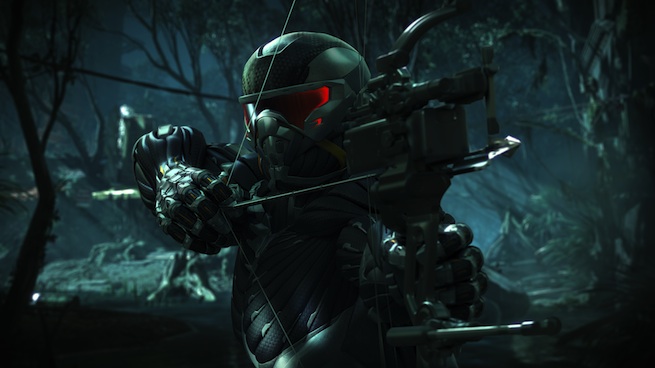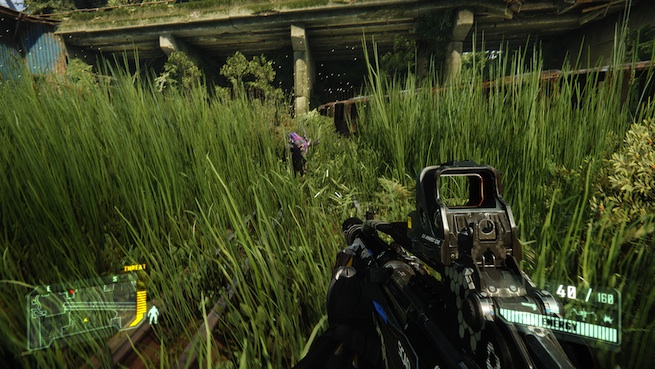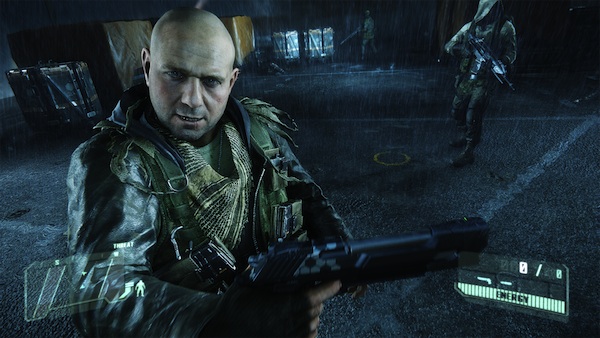The nanosuit is a technical masterpiece. It bonds with the user on a genetic level, giving you the power to augment your strength, protect yourself with extra armor, or turn you invisible with its cloaking capabilities.
But the most effective piece of equipment in Crysis 3 (out today for the Xbox 360, PlayStation 3, and PC) has nothing to do with the suit, the fancy guns, or the explosives — that honor belongs to the hunting bow. It’s all you’ll ever need to take out your human and extraterrestrial foes with extreme precision.
The bow is just one example of developer Crytek’s refined focus on combat in Crysis 3. The first-person shooter (reviewed on the Xbox 360) arguably has the best implementation of the do-whatever-it-takes style set by its predecessors. You’re given complete freedom to dispose your enemies in any way you see fit, a process streamlined with improved nanosuit abilities and upgrades.
The story picks up 23 years after the events of Crysis 2, where the threat of the alien species known as the Ceph continues to grow stronger. But no one except the lone hero Laurence “Prophet” Barnes is aware of this danger, so he must convince everyone else (and stop the conniving Cell corporation) to help him save the world from destruction.
Crysis is typically known more for its taxing PC requirements — and the gorgeous results — than for the actual content on the disc. But Crysis 3 should change that as Crytek delivers a great-looking game with a riveting narrative and the intoxicating gameplay to back it up.
What you’ll like
The Predator Bow
Crytek had a good reason to prominently feature the Predator Bow on the cover of Crysis 3. It’s a permanent fixture in your arsenal — even if you wanted to, you can’t swap it out with something else. And with so many ways to customize it, the bow is the most versatile weapon you’ll wield.
You can adjust its draw weight, which affects the speed of pulling an arrow taut before you release it and alters how much damage it deals. The “medium” draw weight is good for all-around situations, “low” has a fast draw speed meant for weaker targets, and “strong” is best for tougher enemies with its slow draw speed and high damage (it can pin humans and aliens to a wall). In addition to your normal hunting arrows, you can use special types that deliver an electric shock, a timed explosive, or an “air burst” that’s useful for killing groups of weaker enemies.
When you combine the bow with your cloaking ability, you’re unstoppable. Shooting arrows doesn’t disrupt the cloak and leave you vulnerable in the same way that using your firearms does. Cell operatives will cower in fear as you pick them off one by one, with the last survivor making one last desperate attempt to call for reinforcements. What he doesn’t know is that you’re already standing some distance behind him, with your bow aimed squarely at the back of his head.
Stalking your prey
Though we’ve seen the Ceph tear through New York City before in Crysis 2, Crysis 3’s version shows a city dressed in its best postapocalyptic Sunday clothes. Nature’s reclamation of the famous urban jungle — liberally spreading tall leaves of grass, flowers, trees, and swamps between dismantled skyscrapers — makes it nearly unrecognizable.
This makes it the perfect playground for you to use your weapons. While not an open-world game, you have a lot of room to explore and adapt to the many Cell soldiers and Ceph roaming the area. This is where your nanosuit’s tactical visor becomes your best friend: enemy targets and weapon caches clearly appear onscreen (marked by light blue arrows) after you “tag” them with your visor. It’ll also give you detailed information, such as the type of soldier you’re facing, the weapons they carry, and whether they notice you (via a color-coded system).
So you can plan your attacks even before you enter a hostile area. You can kill enemies off quietly with silenced weapons, approach them directly with your armor ability turned on, or find some happy medium between the two. A variety of nanosuit upgrades can further influence which of these paths you take. Think of them as like the multiplayer “perks” you find in Call of Duty (and in Crysis 3), but in a single-player campaign. These upgrades can give you a longer cloaking time, increased health, and over a dozen other nanosuit benefits.
With all these tools at my disposal, I challenged myself to come up with some creative kills, such as shocking groups of enemies in a shallow pond with an electric-powered arrow or stomping them from the air and destroying the survivors with a large machine gun. Swapping between my upgrades on the fly made each combat encounter feel like a thrilling and dynamic puzzle. At the end of my eight-hour adventure, I was still craving more.
‘It was never just about the suit’
The narrative in the first Crysis was too flimsy for my tastes as it was barely more than window dressing for the sandbox-style combat on the fictional island of Lingshan. Crysis 2 fared a bit better but suffered from some last-minute and inexplicable twists. Surprisingly, Crysis 3 brings all those threads together in a coherent and, at times, poignant sort of way.
Much of this centers around Prophet and his struggle over being both man and machine. Covered head to toe with the nanosuit, you’d be forgiven for thinking Prophet is just another cybernetic warrior who came from the same supersoldier school as Halo’s Master Chief. But he’s much more than that. Shaped by the traumatic events of Crysis and the developments in Crysis 2, Prophet isn’t even sure he’s human anymore. Characters and collectible documents often refer to him as an “it” or a piece of “hardware.” Other reports you find have him callously calculating the veracity of people’s statements, and he uses hard numbers and statistics to explain situations rather than communicate with his feelings.
At the outset of Crysis 3, he’s no longer Laurence Barnes the man — he’s Prophet, the most exceptional posthuman soldier ever created. The Cell corporation and the Ceph are obviously more significant threats to the world, but Prophet’s personal narrative is compelling. Seeing how he changes and the way his allies react to those changes is fascinating.
Crysis 3 isn’t some grand philosophical treatise on the dangers of merging humans with technology, but the fact that Crytek attempts to add some meaningful discussion to this sci-fi trope is impressive and way more thought-provoking than I expected.
What you won’t like
Derivative multiplayer
Crysis 3’s multiplayer modes includes all the usual nuts and bolts you see in most FPS games today. Variants on capture-the-flag, king-of-the-hill, domination, and team deathmatch outnumber the few new gameplay types. Customizable loadouts, daily challenges, kill streak power-ups (as well as death streaks), and a leveling system are present as well.
Abilities unique to the nanosuit — air stomps, super jumps, cloaking, and armor — do add a few interesting wrinkles to an otherwise familiar setup. The verticality of the multiplayer maps likewise present interesting opportunities to take down your opponents. And the new Hunter mode is fun if short-lived: teams of two “hunters” (nanosuit players armed with the bow) must kill the other players (human grunts with no nanosuit powers) before time runs out. If the clock hasn’t expired, the dead return to the match as hunters themselves.
But even with the Crysis 3-specific changes, I felt like I’ve been through this before. I’m not sure if it’s enough to sustain a sizable multiplayer community.
Sensory overload
The user interface is sometimes overwhelming. As useful as the tactical visor is, the information contained in its visual icons is a lot to take in. Hours after the tutorial, I still had to remind myself what this color meant or what that bar on the lower left side of the screen was for.
I also felt like Crytek struggled with mapping so many gameplay functions to a single controller — I played the Xbox 360 version, so I didn’t have the luxury of using a mouse and keyboard. In particular, the “back” button was the cause of endless confusion. If you just tap it, it brings up the nanosuit upgrade menu, but if you hold it down, the weapon-customization menu takes over the screen instead. Either option doesn’t pause the action at all, so you can imagine the stress of accidentally triggering one menu over the other during combat.
Conclusion
Crysis 3 is the strongest entry in the franchise. The puzzle-like combat scenarios have never been better with its suite of gameplay options and opportunities while the engaging narrative urges you to see Prophet’s journey through to the end. And if you’re a console owner, you can rest easy knowing that it still looks great on seven-year-old hardware.
However, the PC is still the best way to see and take advantage of the latest advancements in Crytek’s CryEngine 3 — all the screenshots you see here are from that version. Just make sure you have the right specs to pull it off.
Score: 85/100
Crysis 3 released on Feb. 19, 2013 for the Xbox 360, PlayStation 3, and PC. The publisher provided GamesBeat with a Xbox 360 copy of the game for the purpose of this review.
VentureBeat's mission is to be a digital town square for technical decision-makers to gain knowledge about transformative enterprise technology and transact. Learn More





















